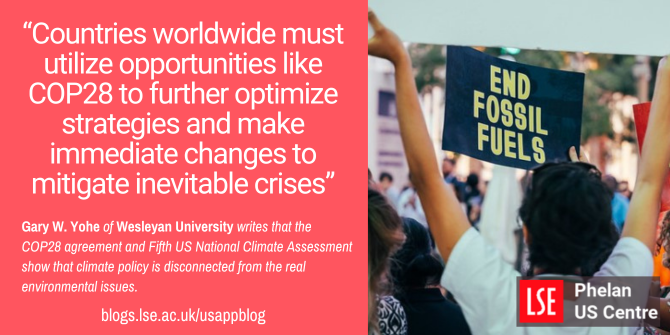 Last week COP28 ended with a deal to encourage countries to move away from fossil fuels and increase the use of renewable energy sources. Gary Yohe looks at the role of the recently published US National Climate Assessment in the context of COP28 and US climate action. He writes that, despite new funding for climate resilience, US climate legislation continues to be disjointed from real environmental issues and calls for better funded research programs to improve climate modelling and mitigation and to find quick solutions for climate risks.
Last week COP28 ended with a deal to encourage countries to move away from fossil fuels and increase the use of renewable energy sources. Gary Yohe looks at the role of the recently published US National Climate Assessment in the context of COP28 and US climate action. He writes that, despite new funding for climate resilience, US climate legislation continues to be disjointed from real environmental issues and calls for better funded research programs to improve climate modelling and mitigation and to find quick solutions for climate risks.
President Biden announced the publication of the fifth United States National Climate Assessment (NCA5) in the White House Press Room on November 14th. The NCA5 is a series of reports on the state of climate change across the country. Its synthesis Overview discusses intensifying weather events and tremendous economic losses from increasing planetary warming. These tipping points and possible mitigation steps are not being discussed by government and research professionals. Countries worldwide must utilize opportunities like COP28 to further optimize strategies and make immediate changes to mitigate inevitable crises.
Progress at COP28 but we are still behind on climate pledges.
This year’s UN Climate Summit resulted in a groundbreaking, though divisive, deal to move away from fossil fuels and scale renewable energy projects. This sounds quite bland in comparison to the climate action scientists were hoping for. But the UAE Consensus is still important. It’s one of the first final COP outcomes to speak about reducing or ending fossil fuel use. However, this vague agreement won’t prevent any climate concerns that are steadily worsening. Keeping global temperatures from rising 1.5C is slipping out of our hands as climate legislation continues to be disjointed from real environmental issues. We are years behind our previous pledges to prevent a worsening climate crisis and investing in high-cost renewable energy sources isn’t the key to saving our planet.
Extreme heat, heavy precipitation, prolonged droughts, riverine and coastal floods, record-setting wildfires, and/or increasingly intensive and erratic hurricanes now affect every region of the country and are becoming more frequent by the day. Direct damages from extreme weather now cost the US at least $150 billion annually. Healthcare-related costs, ecosystem damage, and human life valuations are not included in the calculations.
Billion-dollar disasters that are reported monthly by the National Oceanographic and Atmospheric Administration Administrations (NOAA) are now experienced, on average, once every three weeks compared to once every four months in the 1980s.
Climate change worsens social inequities so that historically underserved communities are more likely to be impacted by environmental hazards and climate change while they are simultaneously less likely to have equal resources to recover after disasters.
The history of US climate assessment
To put the NCA5 into historical context, it is important to note that periodic assessments of the “state of the US climate” were mandated as part of the Global Change Research Act of 1990. The legislation was signed into law by President George H.W. Bush on November 16th of that year. Congressional support for the Act was, by current standards, extraordinarily bipartisan; indeed, it passed the House of Representatives on October 26th and the Senate two days later by voice vote.
So that the NCAs would have a permanent home within the federal government, the Act created the United States Global Change Research Program (USGCRP) under the cabinet-level Office of Science and Technology Policy.

“COP28 2023 – Dia 12 · 12/12/2023 · D” (CC BY-NC 2.0) by midianinja
It is also eye-opening to recall that this bipartisan federal action happened just two years after James Hansen, a scientist working for the National Aeronautics and Space Administration (NASA), had testified before the US Senate on June 23, 1988. Based on his groundbreaking work, Hansen proved that the greenhouse effect was occurring. His findings made it clear that the global climate was changing and that emissions from burning coal were the main culprit.
Neither of these events escaped the skeptical eyes of those who would quickly muster a coordinated campaign of misinformation and disinformation about climate change. Historian Nancy MacLean has carefully chronicled their secret, organized, and well-funded effort to promote “personal security” from the ground up at the expense of responding from the top down to enormous inequality in opportunity across the population.
Personal attacks on scientists involved had far-reaching consequences for how government officials saw climate change. By 2014, only 8 Republicans out of 278 then in Congress acknowledged that human-induced climate risks were real; Republican members of the current Congress, not to mention all the candidates vying for their 2024 presidential ticket, display the a similarly dangerous and dismissive attitude toward climate risk.
Options for climate action
But there is still hope for climate action progress. Abatement and adaptation are society’s two most powerful options. In support of the release of the NCA5, President Biden announced his intent to distribute over $6 billion to strengthen communities’ resilience to climate change impacts through his Investing in America agenda.
Targets for expanded funding include $3.9 billion to bolster the electric grid through the Bipartisan Infrastructure Law, $2 billion to augment the Environmental Protection Agency budget for its work on Environmental and Climate Justice Community Change Grants, $300 million to augment the Federal Emergency Management Administration’s work to reduce coastal flooding risk through its Swift Current Initiative, and so on. This funding will be instrumental in moving the needle towards our net zero goals.
But this proposal and recent behaviors pale on a per capita basis when cast against the 7 billion euro increase in support for climate action across France.
Tipping points in the climate system
And so, what is missing from the NCA5? Tipping points in the climate system and why they are vital to monitor, mitigate, and prevent. But that is not the authors’ fault.
Tipping points endanger human and animal life and economic success. A few examples include the rapid collapse and/or melting of Antarctic and Arctic ice sheets, pervasive ecosystem decline across the Amazon River basin, rapid and potentially irreversible decline of the Atlantic Meridional Overturning Circulation, and the accelerating release of methane from melting tundra.
Truthfully, we do not have a good handle on the physical dynamics of these systems. We are unsure that existing modeling efforts and comparisons adequately inform appropriate mitigating action.
We are not even confident that we are collecting and analyzing the most informative data. Herein lies the need for urgent, significant, well-directed, globally integrated, and well-funded research programs.
Our understanding of the global climate system and its effects was the same late in the last century. While we have taken significant action, that progress took decades to materialize and mature thanks to the systematic and coordinated work of tens of thousands of physical and social scientists.
The truth now is that we simply do not have decades to find solutions to this new era of climate risks. International cooperation between the US and other countries will be critical for accelerating progress and protecting our planet. However, tipping points and major problems with our data collection, modeling, and analysis should also be part of the discussion.
COP28, informed by a thorough review of what we do know about at least five tipping points that were released in Dubai on December 5th, is the perfect time and place to reflect on our successes and failures in the past four decades and take systemic and collaborative action to holistically understand how and why we can and must work to avoid a climate-induced collapse of human life as we know it on our planet.
- Please read our comments policy before commenting.
- Note: This article gives the views of the author, and not the position of USAPP – American Politics and Policy, nor the London School of Economics.
- Shortened URL for this post: https://bit.ly/41CL67q







How can climate policy be better connected to real environmental problems?